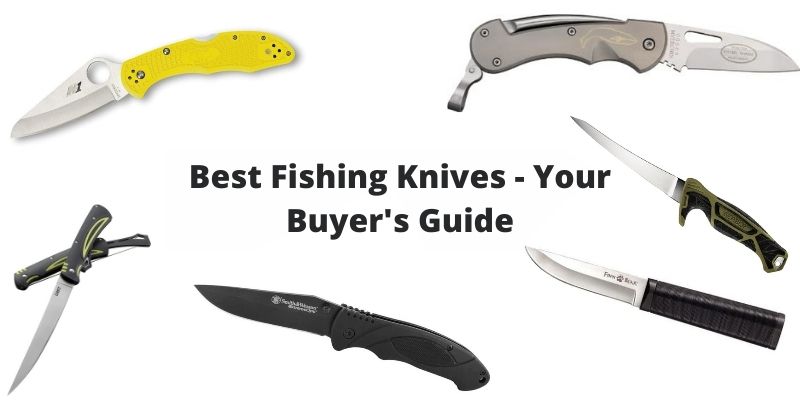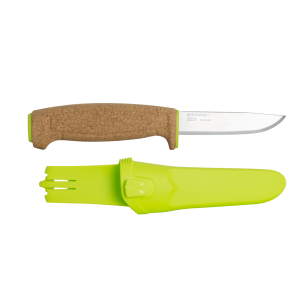Whether you are preparing to cast your first line into a nearby pond, or are a seasoned fisher with years of experience deep sea fishing, a good fishing knife is an absolute must-have tool for the job. A great fishing knife should be able to do everything you need it to do while out on the water, so while specialty knives do exist for tasks like filleting and scaling, we’ll be focusing on all-purpose fishing knives in this guide plus a few recommendations for excellent fillet knives that make a fun optional add-on to your fishing kit.
Here, we’ve gathered all the information you’ll need to make an informed decision when buying your next fishing knife, and are sharing some of our picks for the best knives currently on the market.
Quick Navigation:
Key Features In Fishing Knives | Knife Types | Top Folding Knives | Top Fixed Blade | Top Fillet Knives | Knife Safety
Why Carry A Knife While Fishing?
When packing for a fishing trip, you’ll of course remember your rod and reel, but there is more to a successful fishing trip than just casting and catching. There are plenty of tasks to be accomplished throughout a day of fishing, many of which are made easier with the use of a good fishing knife. Here’s just a few reasons you should always carry a knife when fishing:
Cutting Line
Fishing line is designed to be durable, which means it won’t easily snap in your fingers or in the mouth of a large fish. Fishing line may need to be cut to remove excess, to release a stuck-line, or to solve a jumbled tangle. When fishing line needs to be cut, the best way to do so is with a strong fishing knife, which should easily be able to slice through even the most heavy-duty line.
Prepping Bait
A knife is an excellent tool to help you portion out bait and cut large chunks into small, manageable pieces that will appeal to a hungry fish. While you can certainly accomplish this task without a knife, it will leave your hands feeling grimy and your bait looking less than uniform. Using a fishing knife not only makes bait-prep less messy, but it also drastically cuts the time it takes to get everything ready.
Slaughtering Fish
If you are fishing to keep your catch, you’ll need a quick and easy way to slaughter the fish that you manage to hook on your line. A good fishing knife will have a robust handle, enough heft to give your catch a good wack, and a sharp, sturdy blade that can easily cut through the neck, head, belly, and gills. Having your fishing knife ready to use at any moment will help you to quickly dispose of your catch and get your line back in the water ASAP.
Cleaning and Filleting
Once your fish are slaughtered, the next step is to clean them and remove the guts. Fishing knives are essential for this, and while you can bring several knives to complete the various steps of the process (i.e. gutting and filleting), most fishers will find that one good fishing knife does the trick.
Camping, Cooking, Building Fires, etc.
Many anglers like to camp, cook outdoors, and enjoy the full experience of living off the land and water. A good fishing knife can help you to accomplish more than just fishing and will come in handy on-land to set up your campsite, prepare a fire, cook your fish, and much more.
What To Look for When Choosing a Knife
Every angler has their preference when it comes to the qualities they prefer in their fishing knives, but regardless of whether you like a long, flexible blade or a short, rigid blade, knowing what you are looking for will help you to narrow down the search. Here are the various qualities you should be looking for when choosing a fishing knife:
Blade
The blade of a fishing knife should be durable, resistant to rust and salt-water, easy to keep sharp, and powerful enough to perform the many tasks you demand of it during a fishing trip.
- Material: Fishing knives are used for dirty tasks and don’t need to be made of the most premium metals, but that doesn’t mean you should go for the cheapest option available. Good fishing knives should be made from durable, corrosion-resistant steel or one of the many available alloys. Steel is primarily made from steel and carbon with varying amounts of carbon depending on the type of steel. More carbon creates a harder, sharper edge. Chromium may also be added to increase corrosion resistance, but too much chromium can create fragility in the blade.Most anglers prefer the following blade materials:
- 420 steel: basic stainless steel, superior sharpness, moderate corrosion resistance
- 5Cr & 7Cr steel: all-purpose stainless steel, good sharpenability, and high corrosion resistance
- Powdered steel: extreme strength, sharpenability, and corrosion resistance
- Edge Type: Fishing knife blades can be ground and shaped to create a variety of edges. Depending on the grind, a blade may be more flexible or rigid, may be more suited to one type of task (i.e. cutting through bone or gutting), or may have varying ability to hold a sharp edge. The two most common types of fishing knife-edge are hollow and flat grind blades, but many exist in the world of fishing knives:
- Asymmetrical Grind: An asymmetrically ground blade is one with different shapes on either side. An asymmetrical blade could have a curved edge on the right side with a regular flat edge on the other or any other combination of shapes. Asymmetrical blades are good for experienced anglers that want multiple uses from a single knife, but may not be useful as a general fishing utility knife.
- Convex Grind: A blade with a convex grind is one with a slightly curved or ‘convex’ edge. Rather than tapering straight down from the spine, the edge begins as a moderate then more severe curve. The convex shape helps to make these blades more durable, though they will typically need to be sharpened by a professional when it does come time to maintain the blade.
- Flat Grind: Flat grind blades have a symmetrical grind that starts at the top/spine of the knife and tapers gradually to a point. Flat grind knives are good for all anglers and will hold an extremely sharp edge without needing to be sharpened for quite some time. Unfortunately, flat grind knives are difficult to sharpen on your own, and due to their rigidity, can become fragile with extended use.
- Hollow Grind: Hollow grind blades curve in sharply at the spine to create a thinner blade that meets at a razor sharp point. Hollow grind knives can be made sharper than some other knives but may dull quickly as the blade is thinner and more flexible.
- V Grind: The point of a v grind blade begins further from the spine of the knife, and is shorter in total length. V grind blades are easy to sharpen and maintain but may require more frequent sharpening.
- Point Shape: Like blade edge grinds, fishing knives come with a variety of point shapes that can be beneficial for different tasks and may impact how you use your knife. While there are many point shapes, the two most common point shapes preferred by anglers include:
- Clip Point: Clip point blades begin to slope closer to the top of the blade, often 1-2 inches from the point.
- Drop Point: Drop point blades begin to slope from the handle.
- Length: The length of your blade can impact what types of jobs you can accomplish. Fillet knives are usually between 7.5 inches and 9 inches, while more versatile knives are often shorter. If you want it to be small for storage, you can get a shorter blade, but if you may need to cut thick line, large bait, or other tough objects, a larger knife may be more suitable.
Handle
Next to the blade of a fishing knife, the next most important component is the handle. When selecting a fishing knife, you’ll want to look for a handle made from durable, non-slip material that won’t be affected by water and will sit firmly in your hand no matter how slippery your fishing trip becomes. Any material used to create a fishing knife handle should be durable enough to withstand various weather conditions, must be durable enough to be used to whack fish, and should not deteriorate or become detached from the blade due to exposure to moisture. The best handle materials for fishing knives include:
- Treated wood
- Hard plastic (i.e. nylon)
- Metal
- Rubber
- Cork
Weight
A good fishing knife should have enough heft to be able to cut through tough fish skin and bones, but lightweight enough to be comfortably carried and used in various conditions. Too heavy, and a fishing knife can become unwieldable; too light, and you’ll struggle to accomplish the many tasks you need your knife for. Most fishing knives are within 3-8 ounces (85-227 grams). You can choose based on your preference within that range.
Uses
Finally, when selecting a fishing knife, you’ll want to have a good idea of how you plan to use the knife since this will dictate your choice. Fishing knives can be used for a wide range of tasks, but some are specifically designed to facilitate delicate tasks like filleting or scaling a fish. A good-quality all-purpose fixed blade or folding pocket knife can be used to scale or fillet a fish in a pinch, so don’t be afraid to go minimal if you are trying to avoid overpacking.
Types of Fishing Knives
Many types of fishing knives exist, but here we’ll be focusing on three general types that make great additions to your tackle box.
Manual Fold Pocket Knife
Manual fold pocket knives are outfitted with a hinge, allowing the blade to collapse into a protective space within the handle. Folding knives half in size when closed, making them a great choice to keep in a vest or pants pocket while fishing. Many folding knives also include a clip on one side of the handle which can be used to keep the knife safely in place while in your pocket.
Manual fold pocket knives are easy to grab quickly (and safely) from your pocket and can be opened in seconds to reveal the blade. Once open, the blade of a good manual fold pocket knife will be securely locked open to avoid accidental slipping and to ensure safety during use. Choose this option if you want something compact and versatile.
Fixed Blade
Fixed blade knives cannot be folded, and remain securely in one shape at all times. Most fixed blade knives will come with a sheath for safe storage and can be hung from a belt or kept nearby in a tackle box. Fixed blade gives are extremely durable, making them ideal for cutting through large fish, cutting bones, or using for heavy-duty utility around camp. Also the most traditional option, fixed blade knives are readily available and virtually failsafe.
Fillet Knives
Fillet knives are long, thin, and slightly curved to allow for careful separation of the side fillets from the spine and ribs of the fish. While the task of filleting a fish can be accomplished with a long fixed or folding knife, a fillet knife will make the job easier and create cleaner, more precise cuts. Fillet knives generally are not as versatile as other knives, but they greatly enhance your ability to fillet. If you want a specialty knife for frequent filleting, this is what you should be looking for.
Best Manual Fold Pocket Fishing Knives
Compact, easy to use, and easier to travel with, manual fold pocket fishing knives are ideal for fishing small streams with small fish and doing minor tasks like cutting lines and bait. Keep in mind, this is a short list, so there are hundreds of other quality options. Take note of our suggestions above for choosing the best knives when selecting what’s right for you.
Here are our top picks for the best manual fold pocket fishing knives currently on the market:
Smith & Wesson SWA25 Extreme Ops Folding Knife
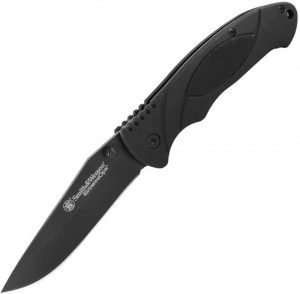 An affordable option from a trusted brand, the Smith & Wesson SWA25 Extreme Ops Folding Knife is a good general utility knife that can easily do more complicated tasks. Though easy to open, you won’t have to worry about this knife slipping open in your pocket since the liner chamber of the handle made to secure the blade features a simple locking mechanism.
An affordable option from a trusted brand, the Smith & Wesson SWA25 Extreme Ops Folding Knife is a good general utility knife that can easily do more complicated tasks. Though easy to open, you won’t have to worry about this knife slipping open in your pocket since the liner chamber of the handle made to secure the blade features a simple locking mechanism.
Price: $11.89-$15.60
Blade Length: 3.3”
Blade Material: 7Cr17MoV high-carbon stainless steel
Point: Clip point
Grind: Flat grind
Handle Material: Aluminum
Total Length: 7.8”
Weight: 3.5 oz.
Notable Features:
- Ambidextrous thumb notches
- Pocket clip
- Liner lock to secure blade
See On Amazon | See On Smith & Wesson
Myerchin TF377 Gen 2 Titanium Crew Knife
 If you know you love folding knives and want to invest in a high-quality general-use folding fishing knife that will last a lifetime, the Myerchin TF377 Gen 2 Titanium Crew is a great option. Made from highly durable titanium and stainless steel, Myerchin knives are so high quality that you’ll find them in the toolkits of US Navy and Coast Guard members. In addition to a sharp clip point blade, the Gen 2 also features a folding spike.
If you know you love folding knives and want to invest in a high-quality general-use folding fishing knife that will last a lifetime, the Myerchin TF377 Gen 2 Titanium Crew is a great option. Made from highly durable titanium and stainless steel, Myerchin knives are so high quality that you’ll find them in the toolkits of US Navy and Coast Guard members. In addition to a sharp clip point blade, the Gen 2 also features a folding spike.
Price: $74.95 – $88.99
Blade Length: 2.3”
Blade Material: German Marine stainless steel – comparable to 440C
Point: Clip point
Grind: High flat grind
Handle Material: Titanium
Total Length: 6.45”
Weight: 2.4 oz.
Notable Features:
- Includes a folding spike
- One-hand assist opening
- Locking mechanism
See On Amazon | See On Myerchin
Spyderco Salt 2 C88PYL2 Folding Knife
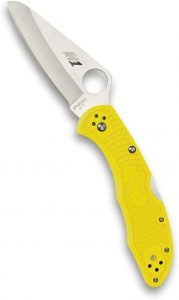 While most high-quality steel will be somewhat corrosion-resistant, not all fishing knives can hold up against regular use for ocean/saltwater fishing. The Spyderco Salt 2 C88PYL2 is built to be 100% corrosion resistant and rust-proof and features nitrogen-based H1 steel. Made in Japan, the Salt 2 features Spyderco’s unique blade hole to reduce friction, and a bright yellow handle (other colors available) to make it hyper-visible even in dark, rainy conditions.
While most high-quality steel will be somewhat corrosion-resistant, not all fishing knives can hold up against regular use for ocean/saltwater fishing. The Spyderco Salt 2 C88PYL2 is built to be 100% corrosion resistant and rust-proof and features nitrogen-based H1 steel. Made in Japan, the Salt 2 features Spyderco’s unique blade hole to reduce friction, and a bright yellow handle (other colors available) to make it hyper-visible even in dark, rainy conditions.
Price: $96.26
Blade Length: 3”
Blade Material: H1 steel alloy
Point: Drop point
Grind: Hollow grind
Handle Material: Fiberglass reinforced nylon
Total Length: 7.25”
Weight: 2.08 oz.
Notable Features:
- Non-rusting metal components
- One-hand open
- Back lock
See On Amazon | See On Fisheries Supply
Best Fixed Blade Fishing Knives
A more traditional choice, fixed blade knives offer superior strength and can easily be used to dispose of large fish, cut through bones, sever thick ropes, and more. Fixed blade fishing knives are easy to grab at a moment’s notice, and offer smooth, clean cuts without concern for the knife folding or collapsing. Here are our 3 picks for the best fixed blade fishing knives you can purchase today:
Morakniv Floating Knife
Designed and made in Sweden, this simple fixed blade knife from Morakniv is about as traditional as you can get when it comes to selecting a fishing knife. Small, lightweight, and comfortable in the hand, this knife will help you to quickly kill and clean your catch, cut line, and other basic fishing tasks. Easy to sharpen and highly durable, this knife is one you’ll carry with you on every fishing trip. Plus, it floats.
Price: $23 – $28
Blade Length: 3.82″ (97 mm)
Blade Material: Stainless steel
Point: Drop point
Grind: V-grind
Handle Material: Cork
Total Length: 8.78” (223 mm)
Weight: 2.8 oz. (79.5 g)
Notable Features:
- Hard plastic sheath with pocket clip
- Lifetime warranty
- Unground spine
See On Amazon | See On Morakniv
Cold Steel Finn Bear Fixed Blade
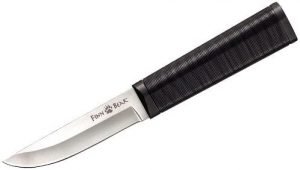 A simple, elegant Finnish design, the Finn Bear from Cold Steel is a good all-around utility knife that offers superior durability, making it useful for disposing of large fish and performing heavy-duty tasks. Featuring a 4” blade, this knife can perform a range of tasks including those that require extreme delicacy. Slip this knife securely into its polymer sheath and wear the Finn Bear safely on your belt or keep it nearby in your tackle box.
A simple, elegant Finnish design, the Finn Bear from Cold Steel is a good all-around utility knife that offers superior durability, making it useful for disposing of large fish and performing heavy-duty tasks. Featuring a 4” blade, this knife can perform a range of tasks including those that require extreme delicacy. Slip this knife securely into its polymer sheath and wear the Finn Bear safely on your belt or keep it nearby in your tackle box.
Price: $17.99 – $18.45
Blade Length: 4”
Blade Material: German 4116 stainless cryo-quenched steel
Point: Drop point
Grind: Hollow grind
Handle Material: Hard plastic – polypropylene
Total Length: 8.5”
Weight: 2.8 oz.
Notable Features:
- SecureEx Sheath (polymer)
- Finnish design
- Handle accommodates various grips
See On Amazon | See On Cold Steel
Marttiini Fisherman’s Condor Knife
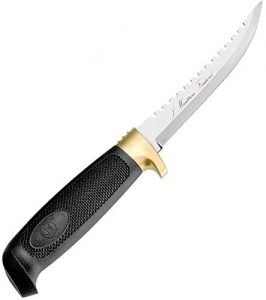 An all-purpose knife that will help you to accomplish any task, the Marttiini Fisherman’s Condor Knife features a thin, super sharp blade, a textured handle for maximum grip, and some special features to increase its utility. Rather than your average smooth spine, this knife features a serrated spine to assist with scaling fish and to help sever thick ropes and cords. Designed and made in Finland, this fixed utility knife combines utility, tradition, and high-quality materials for superior performance.
An all-purpose knife that will help you to accomplish any task, the Marttiini Fisherman’s Condor Knife features a thin, super sharp blade, a textured handle for maximum grip, and some special features to increase its utility. Rather than your average smooth spine, this knife features a serrated spine to assist with scaling fish and to help sever thick ropes and cords. Designed and made in Finland, this fixed utility knife combines utility, tradition, and high-quality materials for superior performance.
Price: $32.98 – $33.79
Blade Length: 4.3”
Blade Material: Stainless steel
Point: Drop point
Grind: Hollow grind
Handle Material: Rubber
Total Length: 9”
Weight: 2.9 oz.
Notable Features:
- Serrated spine
- Leather sheath
- Textured finger guard
See On Amazon | See On Marttiini
Best Fillet Knives
Filleting a fish with a utility fishing knife is entirely possible, but if you want to step up your fishing game and get the most beautiful clean-cut fillets, you’ll want to add a fillet knife to your tackle box. Fillet knives are long, thin, slightly curved, and super sharp, but shouldn’t be used for things like slaughtering fish, cutting line, or starting fires. Here are our top 3 fillet knife picks:
Rapala Fish ‘N Fillet Knife
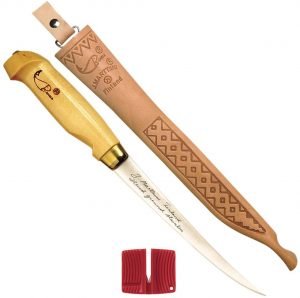 Looking for something with a touch of style? The Rapala Fish ‘N Fillet features a beautiful stainless steel blade with signature carving, a decorated birchwood handle, and a precisely printed leather sheath. Look and feel like a Viking on your next fishing trip while also enjoying the sharp, extreme precision of modern-made stainless steel.
Looking for something with a touch of style? The Rapala Fish ‘N Fillet features a beautiful stainless steel blade with signature carving, a decorated birchwood handle, and a precisely printed leather sheath. Look and feel like a Viking on your next fishing trip while also enjoying the sharp, extreme precision of modern-made stainless steel.
Price: $14.99 – $49.99
Blade Length: 4″, 6”. 7.5″ or 9″ available
Blade Material: Stainless steel
Point: Drop point
Grind: Flat grind
Handle Material: Birch
Total Length: 15”
Weight: 6.72 oz.
Notable Features:
- Decorative leather sheath
- Includes sharpener
- Swedish stainless steel blade
CRKT Clark Fork Folding Fillet Knife
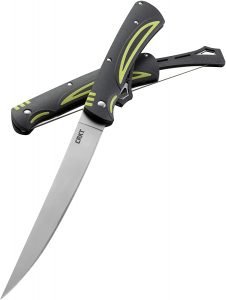 Fillet knives can take up a lot of space in your tackle box, especially when sheathed, but the Clark Fork Fillet Knife from CRKT features a unique folding design that makes this knife super compact. Heavy-duty, easy to pack, and made from corrosion-resistant stainless steel, this knife makes a great addition to any tackle box.
Fillet knives can take up a lot of space in your tackle box, especially when sheathed, but the Clark Fork Fillet Knife from CRKT features a unique folding design that makes this knife super compact. Heavy-duty, easy to pack, and made from corrosion-resistant stainless steel, this knife makes a great addition to any tackle box.
Price: $19.05 – $28.99
Blade Length: 6.03”
Blade Material: 5Cr13MoV stainless steel
Point: Drop point
Grind: Flat grind
Handle Material: Glass-reinforced nylon
Total Length: 10.94”
Weight: 1.8 oz.
Notable Features:
- Glass-reinforced nylon sheath
- Compact design
- Lifetime warranty
Gerber Controller Freshwater Fillet
 Featuring a super-thin, super-sharp blade, this fillet knife will make quick work of even large fish, and help you to quickly prepare your catch for freezing or eating. Built for tough, corrosion-resistant performance, this knife is ideal for freshwater fishing of any kind, and can easily be stored in its sheath hung from your belt.
Featuring a super-thin, super-sharp blade, this fillet knife will make quick work of even large fish, and help you to quickly prepare your catch for freezing or eating. Built for tough, corrosion-resistant performance, this knife is ideal for freshwater fishing of any kind, and can easily be stored in its sheath hung from your belt.
Price: $34.99
Blade Length: 6”
Blade Material: 9Cr18MoV steel
Point: Clip point
Grind: Flat grind
Handle Material: Glass-reinforced nylon
Total Length: 10”
Weight: 8 oz.
Notable Features:
- High-traction handle
- Built-in sharpener
- Molded plastic sheath
See On Amazon | See On Gerber Gear
Fishing Knife Safety
Before we wrap up, we’d like to mention a few important safety tips that will help you to stay safe while using your fishing knives. Designed to be sharp enough to cut through skin and bones, fishing knives are not toys and should always be used with caution. Here are a few basic fishing knife safety tips:
Fishing Knife Laws
Before you bring a fishing knife on your next angling adventure, be sure to research local laws regarding knife size and type. Some states and counties have zero restrictions, and allow you to carry any and all fishing knives at all times. Other states may have rules and standard practices that regulate the carrying of knives, and it is important to comply with local laws.
Cleaning The Blade
Even non-corrosive metals need to be cleaned if you want them to last forever, which is why it is important to always clean and dry your blade after use. Washing your blade in fresh water is adequate to remove salty or bloody residue, and hot soapy water can be used to remove stubborn, stuck-on bits. Once clean, thoroughly dry your blade to prevent rusting. If necessary, apply oil to your blade and sharpen as necessary to avoid letting the blade dull.
Max DesMarais is the founder of hikingandfishing.com. He has a passion for the outdoors and making outdoor education and adventure more accessible. Max is a published author for various outdoor adventure, travel, and marketing websites. He is an experienced hiker, backpacker, fly fisherman, backcountry skier, trail runner, and spends his free time in the outdoors. These adventures allow him to test gear, learn new skills, and experience new places so that he can educate others. Max grew up hiking all around New Hampshire and New England. He became obsessed with the New Hampshire mountains, and the NH 48, where he guided hikes and trail runs in the White Mountains. Since moving out west, Max has continued climbed all of the Colorado 14ers, is always testing gear, learning skills, gaining experience, and building his endurance for outdoor sports. You can read more about his experience here: hikingandfishing/about

